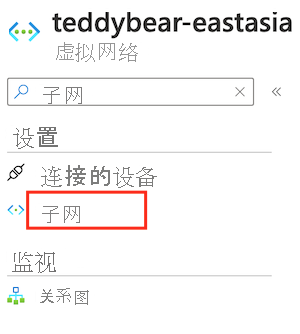练习 - 使用变量和输出循环
对于你所在的玩具公司,你需要在要推出小熊玩具的每个国家/地区部署虚拟网络。 开发人员还要求你为它们提供你已部署的每个区域 Azure SQL 逻辑服务器的完全限定的域名 (FQDN)。
在本练习中,你会将虚拟网络及其配置添加到 Bicep 代码中,并输出逻辑服务器的 FQDN。
在此过程中,你将:
- 更新 Bicep 代码,为每个虚拟网络的子网指定一个参数。
- 添加变量循环以创建子网数组,该数组将用于虚拟网络资源声明。
- 添加输出循环以创建逻辑服务器 FQDN 的列表。
- 部署 Bicep 文件,并验证部署。
将虚拟网络添加到 Bicep 文件
打开 main.bicep 文件。
在参数声明下,添加以下参数:
@description('The IP address range for all virtual networks to use.') param virtualNetworkAddressPrefix string = '10.10.0.0/16' @description('The name and IP address range for each subnet in the virtual networks.') param subnets array = [ { name: 'frontend' ipAddressRange: '10.10.5.0/24' } { name: 'backend' ipAddressRange: '10.10.10.0/24' } ]在参数下面,添加一个空白行,然后添加
subnetProperties变量循环:var subnetProperties = [for subnet in subnets: { name: subnet.name properties: { addressPrefix: subnet.ipAddressRange } }]在文件底部的
databases模块循环下面,添加以下资源循环:resource virtualNetworks 'Microsoft.Network/virtualNetworks@2024-05-01' = [for location in locations: { name: 'teddybear-${location}' location: location properties:{ addressSpace:{ addressPrefixes:[ virtualNetworkAddressPrefix ] } subnets: subnetProperties } }]注意
本示例针对所有虚拟网络使用相同的地址空间。 通常,当创建多个虚拟网络时,如果需要将它们连接在一起,则可能为其提供不同的地址空间。
保存对文件所做的更改。
将输出添加到数据库模块
打开 modules/database.bicep 文件。
在文件底部添加以下输出:
output serverName string = sqlServer.name output location string = location output serverFullyQualifiedDomainName string = sqlServer.properties.fullyQualifiedDomainName保存对文件所做的更改。
通过父 Bicep 文件流式传输输出
打开 main.bicep 文件。
在文件底部添加以下输出循环:
output serverInfo array = [for i in range(0, length(locations)): { name: databases[i].outputs.serverName location: databases[i].outputs.location fullyQualifiedDomainName: databases[i].outputs.serverFullyQualifiedDomainName }]保存对文件所做的更改。
验证 Bicep 文件
完成上述所有更改后,main.bicep 文件应如以下示例所示:
@description('The Azure regions into which the resources should be deployed.')
param locations array = [
'westeurope'
'eastus2'
'eastasia'
]
@secure()
@description('The administrator login username for the SQL server.')
param sqlServerAdministratorLogin string
@secure()
@description('The administrator login password for the SQL server.')
param sqlServerAdministratorLoginPassword string
@description('The IP address range for all virtual networks to use.')
param virtualNetworkAddressPrefix string = '10.10.0.0/16'
@description('The name and IP address range for each subnet in the virtual networks.')
param subnets array = [
{
name: 'frontend'
ipAddressRange: '10.10.5.0/24'
}
{
name: 'backend'
ipAddressRange: '10.10.10.0/24'
}
]
var subnetProperties = [for subnet in subnets: {
name: subnet.name
properties: {
addressPrefix: subnet.ipAddressRange
}
}]
module databases 'modules/database.bicep' = [for location in locations: {
name: 'database-${location}'
params: {
location: location
sqlServerAdministratorLogin: sqlServerAdministratorLogin
sqlServerAdministratorLoginPassword: sqlServerAdministratorLoginPassword
}
}]
resource virtualNetworks 'Microsoft.Network/virtualNetworks@2024-05-01' = [for location in locations: {
name: 'teddybear-${location}'
location: location
properties:{
addressSpace:{
addressPrefixes:[
virtualNetworkAddressPrefix
]
}
subnets: subnetProperties
}
}]
output serverInfo array = [for i in range(0, length(locations)): {
name: databases[i].outputs.serverName
location: databases[i].outputs.location
fullyQualifiedDomainName: databases[i].outputs.serverFullyQualifiedDomainName
}]
database.bicep 文件应如以下示例所示:
@description('The Azure region into which the resources should be deployed.')
param location string
@secure()
@description('The administrator login username for the SQL server.')
param sqlServerAdministratorLogin string
@secure()
@description('The administrator login password for the SQL server.')
param sqlServerAdministratorLoginPassword string
@description('The name and tier of the SQL database SKU.')
param sqlDatabaseSku object = {
name: 'Standard'
tier: 'Standard'
}
@description('The name of the environment. This must be Development or Production.')
@allowed([
'Development'
'Production'
])
param environmentName string = 'Development'
@description('The name of the audit storage account SKU.')
param auditStorageAccountSkuName string = 'Standard_LRS'
var sqlServerName = 'teddy${location}${uniqueString(resourceGroup().id)}'
var sqlDatabaseName = 'TeddyBear'
var auditingEnabled = environmentName == 'Production'
var auditStorageAccountName = take('bearaudit${location}${uniqueString(resourceGroup().id)}', 24)
resource sqlServer 'Microsoft.Sql/servers@2024-05-01-preview' = {
name: sqlServerName
location: location
properties: {
administratorLogin: sqlServerAdministratorLogin
administratorLoginPassword: sqlServerAdministratorLoginPassword
}
}
resource sqlDatabase 'Microsoft.Sql/servers/databases@2024-05-01-preview' = {
parent: sqlServer
name: sqlDatabaseName
location: location
sku: sqlDatabaseSku
}
resource auditStorageAccount 'Microsoft.Storage/storageAccounts@2023-05-01' = if (auditingEnabled) {
name: auditStorageAccountName
location: location
sku: {
name: auditStorageAccountSkuName
}
kind: 'StorageV2'
}
resource sqlServerAudit 'Microsoft.Sql/servers/auditingSettings@2024-05-01-preview' = if (auditingEnabled) {
parent: sqlServer
name: 'default'
properties: {
state: 'Enabled'
storageEndpoint: environmentName == 'Production' ? auditStorageAccount.properties.primaryEndpoints.blob : ''
storageAccountAccessKey: environmentName == 'Production' ? listKeys(auditStorageAccount.id, auditStorageAccount.apiVersion).keys[0].value : ''
}
}
output serverName string = sqlServer.name
output location string = location
output serverFullyQualifiedDomainName string = sqlServer.properties.fullyQualifiedDomainName
如果不是,请复制示例或调整模板以与该示例一致。
将 Bicep 模板部署到 Azure
在 Visual Studio Code 终端中,运行以下代码以将 Bicep 模板部署到 Azure。 此过程可能需要几分钟才能完成,然后你会看到部署成功。
az deployment group create --name main --template-file main.bicep
在 Visual Studio Code 终端中,运行以下 Azure PowerShell 命令,将 Bicep 模板部署到 Azure。 此过程可能需要几分钟才能完成,然后你会看到部署成功。
New-AzResourceGroupDeployment -Name main -TemplateFile main.bicep
注意
请务必使用与前面相同的登录名和密码,否则部署将无法成功完成。
等待部署完成。
验证部署
部署完成后,需要验证是否部署了新的虚拟网络,以及是否按预期为它们配置了子网。
转到 Azure 门户,并确保你位于沙盒订阅中。
选择
沙盒资源组名称 。验证虚拟网络是否已部署到三个 Azure 位置。

选择名为
teddybear-eastasia的虚拟网络。在搜索栏中,输入“子网”。 在“设置”下,选择“子网”。

验证已部署的子网是否具有
subnets参数的默认值中指定的名称和 IP 地址。
检查部署命令的输出。 它应包括已部署的所有三个逻辑服务器的名称和 FQDN,如下所示:

转到 Azure 门户,并确保你位于沙盒订阅中。
选择
沙盒资源组名称 。验证虚拟网络是否已部署到三个 Azure 位置。

选择名为
teddybear-eastasia的虚拟网络。在搜索栏中,输入“子网”。 在“设置”下,选择“子网”。

验证已部署的子网是否具有
subnets参数的默认值中指定的名称和 IP 地址。
检查部署命令的输出。 它应包括已部署的所有三个逻辑服务器的名称和 FQDN,如下所示:
